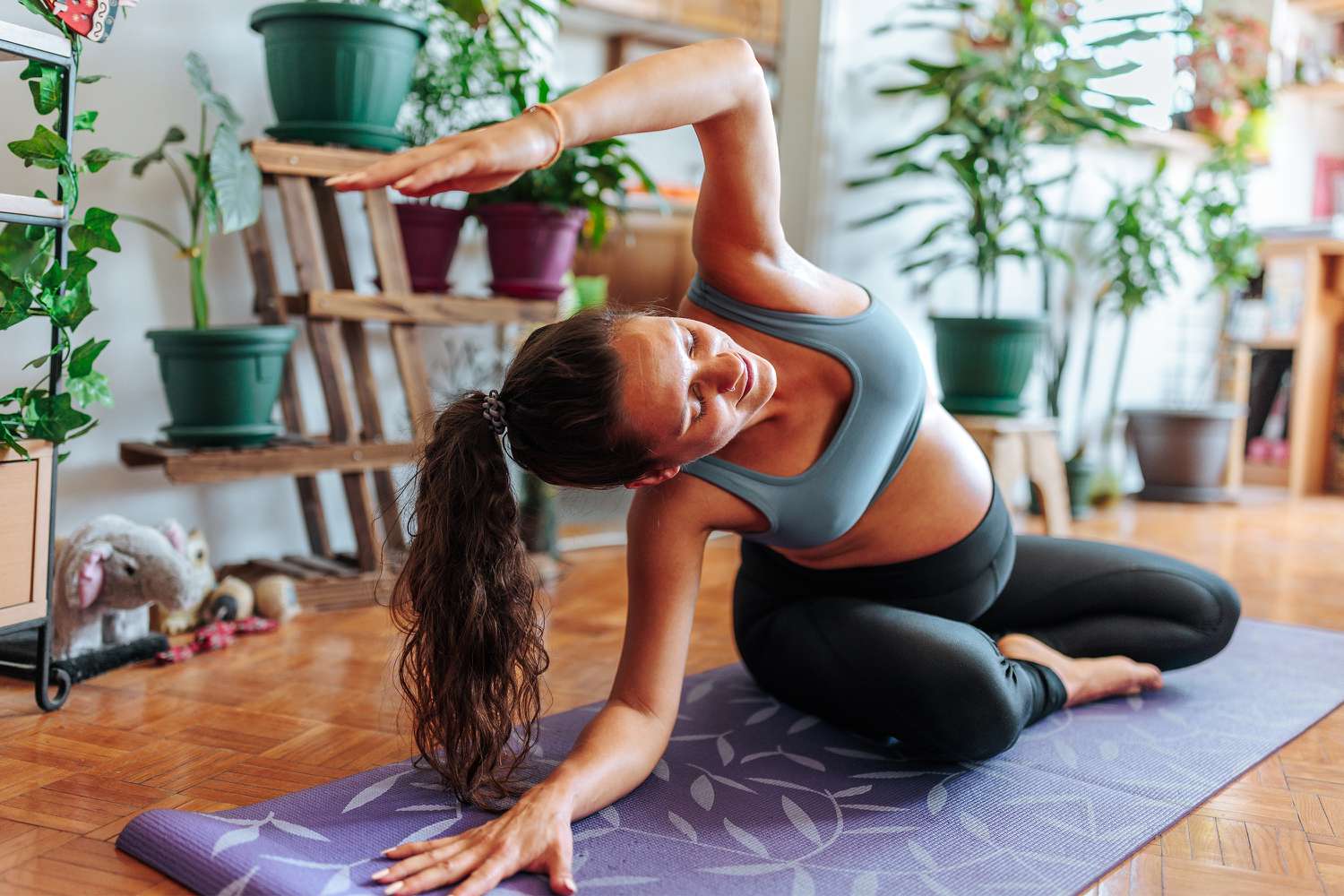The Ultimate Guide to Prenatal Yoga for a Healthy Pregnancy

Pregnancy is undoubtedly a stressful time for a pregnant person's body and mind. From difficulty sleeping to body aches and anxious feelings, navigating the mental and physical toll of growing a new life can be particularly taxing. For this reason, you need a way to lift some of this burden: prenatal yoga may be just the answer.
Not only does prenatal yoga offer a gentler approach to fitness during pregnancy but it is also tailored to the needs and concerns of pregnant people. Plus, it gives you an alternative form of exercise—especially if your go-to workout isn't the safest (or most comfortable) during pregnancy.
Below, experts explain the ins and outs of prenatal yoga. You will find information on the benefits of prenatal yoga, how to do it safely, and ways it can help throughout pregnancy.
Simply put, prenatal yoga is a form of yoga designed specifically to benefit people who are pregnant, says Monte Swarup, MD, FACOG, board-certified OB/GYN in Chandler, Arizona. 'It was started in India and has been used there for centuries to prepare for pregnancy and childbirth.'
During a prenatal yoga class, you can expect to utilize gentle movement and mindful breathing to develop strength, flexibility, balance, and mindfulness, explains Amelia Groves, master yoga trainer at YogaSix. Prenatal yoga also helps students adapt to pregnancy changes in the body through reflection and exercise. It also prepares the body for labor by focusing on increasing strength, building endurance, engaging the mind, and breathing deeply.
'Students are encouraged to connect with their breath and practice deep breathing techniques to relax consciously to prepare their bodies for the demands of labor and childbirth,' says Groves.
Prenatal yoga has been linked with numerous benefits for pregnant people, many of which have been studied and confirmed, says Amy Goh, CNM, a certified nurse midwife and registered yoga teacher at Ovia Health by Labcorp.
'Randomized control trials have demonstrated that prenatal yoga is safe in pregnancy and may decrease anxiety, stress, depression, and discomforts,' she says. 'Smaller studies have even demonstrated that pregnant people who took part in a prenatal yoga intervention had shorter lengths of labor and increased odds of vaginal birth compared to pregnant people that did not practice yoga.'
Prenatal yoga also can address sleep issues, which are a common occurrence among pregnant people. In her practice, Groves says she has noticed that her prenatal yoga students sleep better when practicing regularly. 'Many students also experience reduced stress, anxiety, and fear after beginning this practice,' she says.
One common complaint during pregnancy is back pain. Prenatal yoga can be an excellent way to mitigate and reduce back pain, as well as other discomforts.
If you are considering adding prenatal yoga to your exercise routine, it is important to consult your OB-GYN first to ensure the practice is right for your individual situation, says Elma Panagaki, certified prenatal yoga instructor at Bay Club El Segundo. 'Once approved, during your practice, remember to listen to your body and take breaks if you need them, drink plenty of water, and do not be afraid to speak up and ask for a variation if something doesn’t feel right or comfortable.'
Panagaki also recommends using traditional props, like yoga blocks, straps, and bolsters, to make the practice even more comfortable. It's important to maintain a stable base during prenatal yoga.
At 20 weeks pregnant or greater, Swarup urges prenatal yoga practitioners to avoid positions that require them to spend time lying on their backs. Additionally, it is important to remember that balance becomes an issue in pregnancy and the risk of falls increases.
When practicing prenatal yoga, Goh recommends avoiding postures that move the abdomen into the body, such as a closed twist, and avoiding twisting the abdomen in general. 'Twists in yoga may also compress the inferior vena cava (IVC), the largest vein that supplies blood to the heart,' explains Goh. You also will want to avoid any position that requires you to lay on your belly after the first trimester.
If you plan to practice prenatal yoga, most experts urge you to start early in the pregnancy to get familiar with the positions. A few poses that Panagaki recommends for her prenatal yoga clients include:
Nadi shodhana, also known as 'sweet breath,' is a prenatal yoga breathing technique often recommended during pregnancy, explains Briohny Smyth, certified yoga instructor at Alo Moves. 'It's a great starting point for beginners if you've been wanting to add more conscious breath to your day or your yoga practice. It's very easy to follow, and it calms and rejuvenates the nervous system.'
This technique involves putting your right hand in front of your face and resting your middle and pointer fingers between your brows. Close your eyes, take a deep breath through your nose, and back out through your nose. Using your thumb, hold your right nostril, and inhale several breaths through the left nostril. Repeat these steps on the other side. Do this exercise for five to 10 cycles for the best results.
'Another breathing technique you can practice is bhramari, also known as 'bee breath,' which can help soothe your nerves, stimulate your pineal and pituitary glands, and lower your blood pressure,' says Smyth. To perform this, gently close your lips, part your teeth, and bring the tip of your tongue behind your front teeth. Hold your ears closed with your thumbs, and place your fingers across your eyes so the tips meet at your nose. Take a long, deep breath through your nose, filling your stomach. Drop your chin to your chest and exhale slowly, humming with your tongue as you exhale. Repeat this process seven or so times for the best results.
Sometimes, the hardest part of practicing yoga is unrolling the yoga mat to get started. If you want to practice prenatal yoga but are short on motivation or energy, Goh recommends keeping that mat unrolled and finding moments in your day to practice in short intervals.
'Whether you are caring for a child, working at a desk, or standing all day, there will be moments where you need to take a break,' she says. 'You can do a modified downward dog at the wall, your desk, or the playground. Stretch your arms up and take five breaths while seated, then take an open twist and another five breaths.'
Paganaki recommends finding your favorite poses, and then incorporating them throughout the day. 'Find a quiet place, pick a mat that you like, put on some relaxing music, and use some lavender oil. After a few weeks, you will realize how much it helps and how amazing you will feel, and your practice over time will encourage you to do it even more.'
If yoga isn't your thing, but you still want to stay active, other pregnancy-safe exercise options can provide similar benefits, says Goh. 'Walking and swimming are wonderful ways to both move your body and help calm the mind.'
And, if you're finding it difficult to sit still and meditate, try taking the meditation along with you, she adds. 'Meditation can be performed while participating in both of these activities by focusing on the breath while engaging in these types of movement.'




